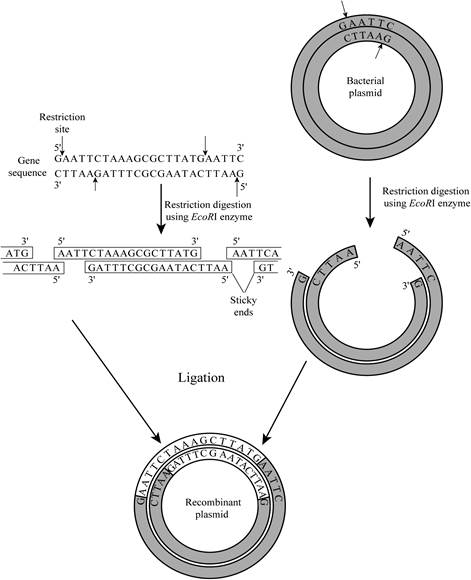
Concept explainers
Describe how the process of gene doning results in a cell clone contaning a recombinant plasmid.
To explain: The gene cloning process that produces a cell clone having a recombinant plasmid.
Concept introduction:
To study a particular protein, multiple copies of the gene fragment encoding that protein are synthesized. These gene fragments are then inserted into the expression vector to synthesize a large quantity of protein that is encoded by the gene. This is known as gene cloning.
Explanation of Solution
For cloning a eukaryotic gene, the bacterial plasmid vector and the gene segment to be cloned are cleaved with the same restriction sites. Fig. 1 shows the cloning procedure using EcoRI restriction enzyme as both the sequences have their restriction sites. The arrows between the bases in Fig. 1 represent the restriction sites. The restriction digestion of the linear gene sequence and the plasmid sequence produces sticky ends. The digested gene sequence is ligated into bacterial plasmid and the recombinant plasmid is synthesized. This recombinant plasmid is reintroduced into the host cells (bacteria), where the eukaryotic gene expresses and forms proteins. The bacterial cells containing the recombinant plasmids will divide to form cell clones.
Pictorial representation:
Fig. 1 shows the cloning procedure using a gene sequence and bacterial plasmid.

Fig. 1 Cloning procedure
Want to see more full solutions like this?
Chapter 20 Solutions
Campbell Biology Plus Mastering Biology with Pearson eText - Access Card Package (11th Edition)
Additional Science Textbook Solutions
Biological Science (6th Edition)
Applications and Investigations in Earth Science (9th Edition)
Genetics: From Genes to Genomes
Campbell Essential Biology (7th Edition)
HUMAN ANATOMY
Physics of Everyday Phenomena
- What is the result of the acid-fast stain below: Stock Images by Getty Images by Getty Images by Getty Images by Getty Image Getty Images St Soy Getty Images by Getty Images by Getty Images Joy Getty encapsulated O endosporulating negative ○ positivearrow_forwardYou have a stock vial of diligence 75mg in 3ml and need to draw up a dose of 50mg for your patient.how many mls should you draw up to give this dosearrow_forwardYou are recquired to administer 150mg hydrocortisone intravenously,how many mls should you give?(stock =hydrocortisone 100mg in 2mls)arrow_forward
- If someone was working with a 50 MBq F-18 source, what would be the internal and external dose consequences?arrow_forwardWe will be starting a group project next week where you and your group will research and ultimately present on a current research article related to the biology of a pathogen that infects humans. The article could be about the pathogen itself, the disease process related to the pathogen, the immune response to the pathogen, vaccines or treatments that affect the pathogen, or other biology-related study about the pathogen. I recommend that you choose a pathogen that is currently interesting to researchers, so that you will be able to find plenty of articles about it. Avoid choosing a historical disease that no longer circulates. List 3 possible pathogens or diseases that you might want to do for your group project.arrow_forwardnot use ai pleasearrow_forward
- DNK dagi nukleotidlar va undan sintezlangan oqsildagi peptid boglar farqi 901 taga teng bo'lib undagi A jami H boglardan 6,5 marta kam bo'lsa DNK dagi jami H bog‘lar sonini topingarrow_forwardOne of the ways for a cell to generate ATP is through the oxidative phosphorylation. In oxidative phosphorylation 3 ATP are produced from every one NADH molecule. In respiration, every glucose molecule produces 10 NADH molecules. If a cell is growing on 5 glucose molecules, how much ATP can be produced using oxidative phosphorylation/aerobic respiration?arrow_forwardIf a cell is growing on 5 glucose molecules, how much ATP can be produced using oxidative phosphorylation/aerobic respiration?arrow_forward
 Biology 2eBiologyISBN:9781947172517Author:Matthew Douglas, Jung Choi, Mary Ann ClarkPublisher:OpenStax
Biology 2eBiologyISBN:9781947172517Author:Matthew Douglas, Jung Choi, Mary Ann ClarkPublisher:OpenStax Human Heredity: Principles and Issues (MindTap Co...BiologyISBN:9781305251052Author:Michael CummingsPublisher:Cengage Learning
Human Heredity: Principles and Issues (MindTap Co...BiologyISBN:9781305251052Author:Michael CummingsPublisher:Cengage Learning Concepts of BiologyBiologyISBN:9781938168116Author:Samantha Fowler, Rebecca Roush, James WisePublisher:OpenStax College
Concepts of BiologyBiologyISBN:9781938168116Author:Samantha Fowler, Rebecca Roush, James WisePublisher:OpenStax College Biology (MindTap Course List)BiologyISBN:9781337392938Author:Eldra Solomon, Charles Martin, Diana W. Martin, Linda R. BergPublisher:Cengage Learning
Biology (MindTap Course List)BiologyISBN:9781337392938Author:Eldra Solomon, Charles Martin, Diana W. Martin, Linda R. BergPublisher:Cengage Learning
 Human Biology (MindTap Course List)BiologyISBN:9781305112100Author:Cecie Starr, Beverly McMillanPublisher:Cengage Learning
Human Biology (MindTap Course List)BiologyISBN:9781305112100Author:Cecie Starr, Beverly McMillanPublisher:Cengage Learning





